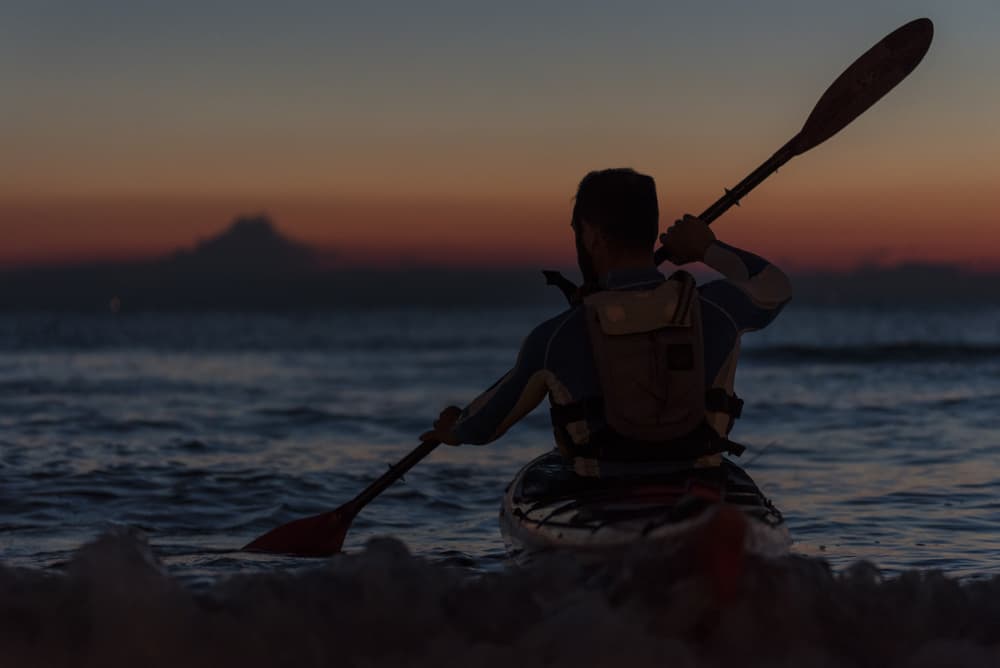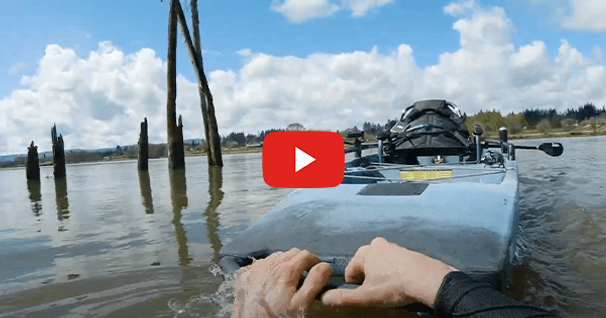Paddling At Night - Tips and Safety Recommendations

Paddling at night can be an invigorating experience. People venture out in kayaks and SUP boards into the sunset and after dusk with all sorts of different ambitions. Whether a paddler is on the hunt for bioluminescence, or hoping for a front-row seat to a fireworks display, the reasons for night paddling are plentiful.
Night paddling is something many avid paddlers have done, whether intentionally or rather unintentionally. When done intentionally, a night paddle is loads of fun, and the story night sky can provide a canvas for memories that will last forever.
Paddling at night is epic, but it is also significantly more dangerous than paddling during the day. So while safety is always important while paddling, this becomes significantly more crucial when you decide to paddle out into the great unknown at night. You need to make sure you pack all the right gear and take all the necessary steps to prepare for this unique type of paddling trip.
If you have a night paddle planned soon or have always been curious about exactly what the prep work is for such an adventure, read below. After all, knowing is half the battle. As long as you take all the steps to ensure your safety and well-being, then there is no reason your evening adventure should feel less safe than one in the sun.
Key Safety Tips To Remember When Night Paddling
Make Sure You Can See And Be Seen
Arguably the most important safety issue when it comes to paddling at night is visibility. First, you need to make sure that other boats can see you. This is critical so that no motorized boat gets too close to you, or speeds by you causing a dangerously-high wake. There are also rules and guidelines that dictate proper lighting for paddle crafts when out on the water.
Some people use waterproof LED lights on the sides of their kayaks. This helps shed a bit of light on the water while also making sure boats can see you from a distance.
It is also important that you can see. Sure, you have your night vision, but that only works so well - especially on cloudy or moonless nights. This is where a spotlight in front of your SUP board or kayak comes in handy. These lights allow you to see if in front of you.
Keep in mind that while lights are critical, the wrong lights can have adverse effects. Poorly positioned and bright lights can throw off your night vision, and in turn, make it very difficult for you to see your surroundings. Read further on to learn a few tips to help ensure you preserve your night vision on an evening paddle.
Know You’re Route In Advance
During the day you might enjoy hopping on your board or in your kayak and exploring the unknown channels and coves around you in a spontaneous and casual manner. This is possible during the day, but dangerous and often-impossible after nightfall.
You should always have a firm plan as far as your route is concerned when paddling in the evening. This will prevent you from running aground, finding yourself in a current, or wandering into more dangerous waters. It also prevents you from getting lost, which is significantly easier when the sun goes down.
Have Nighttime Bearings In Mind
Just as it is important to have a route mapped out, you also should consider ways to follow that route. Think of lighthouses, buoys, or lights on shore that you can keep track of to help you know your bearings. This will become helpful and reassuring as the evening grows darker.
Share Your Itinerary With Someone Staying On Land
One great way to have checks and balances and help ensure your safety if something goes wrong is to tell someone about your trip. Share your route, itinerary, boat information, and especially the time you plan to leave and the time you plan to return. Make it a point to contact this person right before you head out, and let him or her know when to expect to hear from you.
While night excursions should always be done as a group or a pair rather than alone, if you do choose to paddle at night alone, telling someone else is essential.
Pack The Right Gear
You should always bring the right safety gear when paddling a kayak or SUP, and this becomes even more true in the evening. While you can leave the sunglasses, hat, and sunscreen at home, there are other essentials you should make sure you remember for a nighttime paddle. Below is a list of essential safety gear to bring along on any paddle that involves some darkness.
Headlamp and another light source for the hull or bow of the boat.
Ample Water
Dry Bag With a communication device, essential safety kit
Wetsuit if the temperature drops
GPS (ideally a smartphone with a waterproof case or waterproof smartwatch)
Know The Local Laws
While safety should be your first concern, you should also make sure you aren’t breaking any laws. With sundown and evening hours comes both darkness and strict curfew laws in some places.
Many beach parks, and even bodies of water, are off-limits after certain times. You might be within the law when you paddle out, but returning to that same beach later at night can result in a trespassing violation. So make sure where you launch and land for your night paddle is both safe and legal.
Avoid Areas Trafficked By Motorboats At Night
Paddling in a bay that is close to nearby towns and harbors is often safer than paddling at night in the middle of nowhere. But sometimes these harbors can pose their own safety issues in the form of heavy evening traffic.
Busy harbors should be avoided at sunset onward if possible. Even with proper lighting and safety gear, a fast moving power boat is probably not looking out for kayakers after dusk.
If you do paddle in a busy area, make sure you know the boat lanes, do your best to avoid those areas, and only cross them in no-wake zones where boats must travel at very slow speeds.
Check The Weather And Moon
Just because you saw a beautiful sunset it does not mean the evening will be just as ideal. Weather along coasts is notoriously fickle. This means it is imperative that you check the weather before heading out on a night paddle.
In addition to wanting to avoid hazardous weather like wind and rain, you also want to know the cloud cover. While clouds don’t necessarily pose threats, they do significantly decrease evening light. After all, they block the stars and moon.
It is also a good idea to know the stage of the moon. Full moons are ideal for adding more light to the night sky and helping you navigate on your paddle. If, however, you are paddling to see bioluminescence, then a new moon and cloud cover are actually better.
Helpful Tips To Ensure You Have A Great Night Paddle
Consider Going With A Group
Perhaps you are a solo paddler, or a bit shy. Either way, consider possibly breaking the solo paddler streak and joining others on a night paddle.
There is power in numbers. It makes it easier to see and it is easier to get help. So if this is a popular night paddle - like spotting bioluminescence, paddling to see fireworks, or seeing a meteor shower - then try and join a group.
Ask People Who Have Done The Night Paddle Before
If you can get some intel on the trip, then do so. Knowledge is power. Also, while this guide is helpful for any night paddle situation, every body of water and location is different. So the more local information you can get on your particular destination, the better.
Choose Lighting That Doesn’t Hurt Your Night Vision
You want lighting, but you don’t want to mess up your night vision. So consider having lights that point outward to help you see and be seen. You should also wear a waterproof headlamp if you have one, but only put it on when a boat is coming, or when you need it. Relying just on a headlamp can ruin your night vision.
Do The Route During The Day As A Practice Run
If you are night paddling in an area you aren’t all that familiar with - try getting familiar with it. Doing a night paddle route during the day first is always a good idea. You can notice any tricky currents and shallow areas you didn’t anticipate.
Stick To The Coast
There are so many reasons you do not want to paddle into open water at night. From the highly dangerous seas to large underwater creatures, fast moving boats - the reasons are endless.
Stay close to the shore, hugging the coast as much as you can. This keeps you close to safety, and makes sure you keep your bearings and wits about you.
Trust Your Gut
Lastly, remember to listen to your instincts. If something feels a bit off when you are paddling out at night, or you are nervous, then turn back. Remember there is always tomorrow. If you feel any apprehension about going out further, then don’t.
Final Thoughts On How To Safely Paddle At Night
Paddling at night can be epic, and you can even have a bucket-list-worthy paddling trip given the right conditions. But when you know you have plans to paddle at night, make sure you take all the right steps to ensure your safety. This means packing all the right gear, checking the weather, and making sure that you have light to see and be seen.
Also make sure to map out your route, and even do the route during the daytime so you know what to expect. Try and get some friends to join you. If you end up paddling solo make sure you have an emergency contact device, and also tell your route and plans to someone onshore.
Related Articles
Getting back on your sit-on-top kayak isn't that hard - if you know how. That's why it's a great idea to…
The most important knot for all paddlers to know is the Trucker’s Hitch knot. It is a simple knot that…
This Point Of View account of the decisions made prior to an outing visibly shows the importance of…
Learn a valuable lesson about always wearing your life jacket from paddling legend Salty Jefferson…



